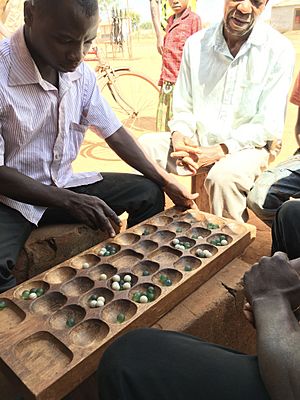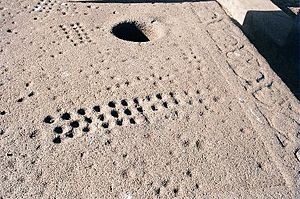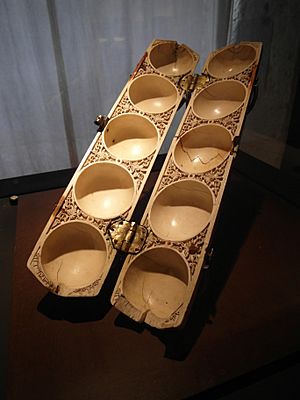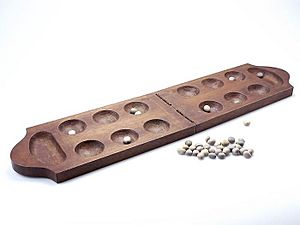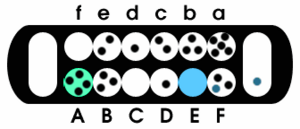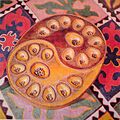Mancala facts for kids
Mancala is a group of fun strategy board games for two players. You play with small stones, beans, or seeds. The game board usually has rows of holes or pits. The main goal is often to collect more of your opponent's pieces than they do.
These games are very old! Some versions date back to the 3rd century. There's even proof that Mancala was played in Ancient Egypt. It's one of the oldest games still enjoyed by many people around the world today.
Contents
The Long History of Mancala
The oldest Mancala boards ever found were in 'Ain Ghazal, Jordan. They were on the floor of a very old house, dating back to about 5,870 BC! People also found signs of the game in Kenya and Israel. In Israel, pottery boards and rock carvings were found in a Roman bathhouse. These date back to the 2nd and 3rd centuries AD.
Other early finds include pieces of pottery boards and rock carvings in Aksumite areas. These places are in Matara (Eritrea) and Yeha (Ethiopia). Archaeologists believe these are from the 6th and 7th centuries AD. A writer named Giyorgis of Segla might have mentioned a game like Mancala in his book from the 14th century.
Mancala Spreads Across the World
Mancala games were also played in Eastern Europe. In Estonia, a game called "Bohnenspiel" was very popular. In Bosnia, it's called "Ban-Ban" and is still played today. You can also find it in Serbia and Greece. Two Mancala boards from the early 1700s are in a castle in Germany.
In the United States, a traditional Mancala game called Warra was played in Louisiana in the early 1900s. A popular version called Kalah became famous in the 1940s. In Cape Verde, the game is known as "ouril." People from Cape Verde brought it to the United States, and it's still played in their communities in New England.
Historians think Mancala was brought to the Americas by enslaved Africans. They played the game to build community and social skills. Archaeologists have even found possible evidence of Mancala at the Hermitage Plantation in Nashville, Tennessee.
Studying the rules of Mancala games helps us understand how they spread. This spread often matches old migration routes, showing how people moved around hundreds of years ago.
What Does "Mancala" Mean?
The word Mancala comes from an Arabic root word, naqala. This word means "to move." So, Mancala is basically a "moving" game!
How to Play Mancala
Most Mancala games follow a similar pattern. Players start by putting a certain number of seeds into each hole on the game board. The number of seeds depends on the specific game. Players often count their stones to plan their moves.
A turn involves picking up all the seeds from one hole. Then, you "sow" the seeds. This means you drop one seed into each of the next holes in a row. The goal is usually to put the most seeds into your "bank" or "store" hole. This is why Mancala is sometimes called a "count and capture" game.
Capturing Pieces
In many games, if your last seed lands in an empty hole on your side, you might get to "capture" your opponent's pieces. These are usually the pieces directly across from your empty hole. Once you capture them, you put them in your own bank. Sometimes, your opponent might even lose a turn after you capture.
What You Need to Play
You usually need a board with holes arranged in rows, often two or four. Boards can be made from many things, like wood, clay, or other materials. Sometimes, people just dig holes in the earth or carve them into stone. These holes are called "depressions," "pits," or "houses." Some boards have larger holes at the ends called stores for holding captured pieces.
The playing pieces are usually small items like seeds, beans, stones, or shells. They are all similar and are moved from hole to hole during the game.
Different Board Sizes
Mancala boards come in many sizes. For example, the game Endodoi can be played on boards with 2 rows of 6 holes up to 2 rows of 10 holes. The biggest game is Tchouba from Mozambique, which has 160 holes (4 rows of 40!) and needs 320 seeds! En Gehé from Tanzania can have up to 50 pits per row, using 400 seeds.
There are also tiny versions! Nano-Wari has only two pits and eight seeds. Micro-Wari has four pits and four seeds.
On a two-row board, players usually control their side. But moves often go into the opponent's side too. On a four-row board, players control an inner and an outer row. Their seeds usually stay in these two rows unless captured.
How to Win
In most two- and three-row Mancala games, the goal is to capture more stones than your opponent. In four-row games, you might try to make it so your opponent has no legal moves left. Sometimes, the goal is to capture all the pieces in your opponent's front row.
At the start of your turn, you pick a hole with seeds to "sow" around the board. You can usually only pick holes on your side that have a certain number of seeds.
When you "sow," you drop one seed into each hole, moving around the board. This is called a "lap." If your last seed lands in an empty hole, your turn might end. This is a "single lap" game.
Some games have "multiple laps." If your last seed lands in a hole that already has seeds, you pick up all the seeds from that hole (including the one you just dropped) and keep sowing! This continues until your last seed lands in an empty hole. Another way to get multiple laps is if your last seed lands in your special "store" hole.
Some games from India use "pussakanawa laps." Here, if your last seed lands in a hole, you don't pick up those seeds. Instead, you continue sowing from the *next* hole. This type of lap ends when you reach an empty hole. If you make a special "point move" in some games, you might get an extra turn!
Different Names and Game Types
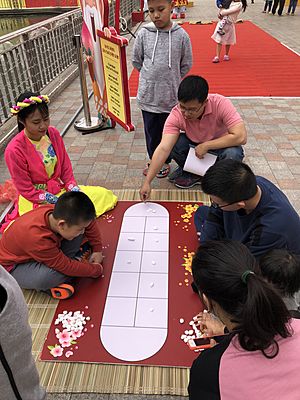
"Mancala" is a general name for a type of game, not just one specific game. There are many popular Mancala games around the world:
- Bao – Played in many parts of East Africa, like Kenya, Tanzania, and Madagascar.
- Gebeta – Played in Ethiopia and Eritrea.
- Kalah – A version from North America, it's the most popular Mancala game in the Western world.
- Omweso – Played in Uganda.
- Oware – Very popular game from the Ashanti in West Africa, but played worldwide, including Europe and the Caribbean.
- Pallanguzhi – Played in Tamil Nadu, India.
- Songo – Played in Cameroon, Equatorial Guinea, and Gabon.
- Sungka – Popular in Southeast Asia, with versions like Congklak and Dakon. You often see these boards in fairtrade shops.
- Toguz korgool or Toguz kumalak – Played in Kyrgyzstan and Kazakhstan.
- Eson Khorgol – Played by the Kazakh people in Mongolia.
There are over 800 known names for traditional Mancala games! Some names are for the same game, while others are used for different games. Almost 200 new versions have also been created.
Mancala Competitions
Some groups of Mancala games have their own tournaments. Mancala has even been part of the Mind Sports Olympiad, which is like the Olympics for board games and mind sports!
Mancala at the Mind Sports Olympiad
| Games | Gold | Silver | Bronze |
|---|---|---|---|
| London 2015 |
Yoon-Ji Bae |
Yeon-Woo Choi |
Hyo-Seok Lee |
| Online Grand Prix 2023 |
Pavel Noga |
Maurizio De Leo |
David Alatorre López |
Images for kids
-
Bao players in Zanzibar
-
A toguz korgool board with balls, Kyrgyzstan
See also
 In Spanish: Mancala para niños
In Spanish: Mancala para niños


